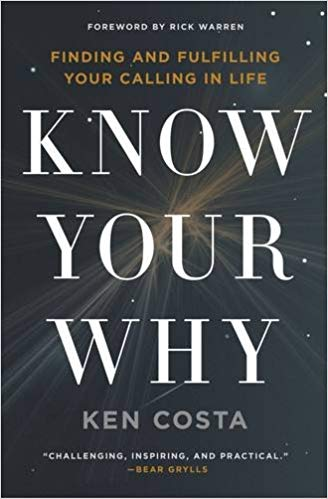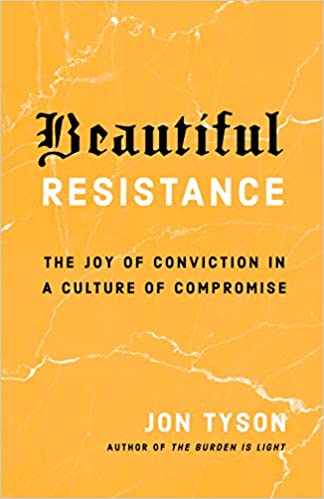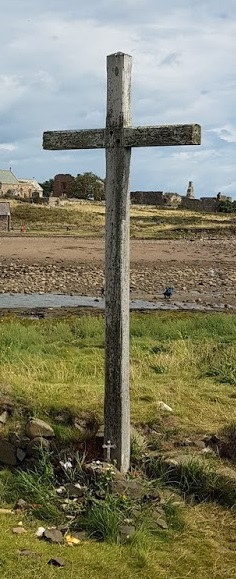Review: Know Your Why – Finding and Fulfilling Your Calling in Life
 Sometimes I read an excellent book that I find deeply frustrating. This is one of those times.
Sometimes I read an excellent book that I find deeply frustrating. This is one of those times.
Ken Costa’s Know Your Why is well written, right-hearted, and helpful. This is a book about vocation. If you are interested in what it means to live according to the calling of Christ, especially if that calling is within the marketplace of the “secular” world, this book would likely bless you. Costa is not only successful in the world of finance and investment, he is one of the key leaders behind Holy Trinity Brompton (HTB) and the Alpha movement. Know Your Why could easily be the “Beta” course – a follow-on curriculum about introductory discipleship for real people in the real world. What’s not to like?
Yet I find myself set on edge. In this review, therefore, I am taking a lead from my own reaction. I need to be clear about that. I’m not trying to whinge or tear down. I’m exploring my response and attempting to articulate my disquiet. I am checking myself for a critical spirit!
I must admit a bias. I didn’t know Costa’s background when I ordered the book, and when I made the HTB connection I found myself wearily sighing. Why? Maybe the pages of endorsements from the pantheon of Christian celebrities provoked my cynicism. Nevertheless, why so critical, O my soul? On the face of it, HTB and Alpha should be “my team” to cheer for. They are the face of charismatic Anglicanism, and it’s not the skin-deep prosperity-peddling Trumpist forms that have a similar appearance in other places. The HTB/Alpha movement has birthed or nurtured new Christians, new church fellowships, worship leaders I admire, and even the current Archbishop of Canterbury. Why can I not sit with this book, that is full of some decent wisdom and pastoral guidance, and savour it freely like a fine refreshing tonic? I should be reading books like this as if it is from a friend to a friend. But I can’t. And if I try, I’m pretending.
Here’s the thing: Every time I find myself walking in proximity to the HTB hegemony, I don’t feel like a fellow-pilgrim, I feel like a customer. I read books like this looking for resonance with my own journey. I hope to find some guidance, some solace, or even some rebuke and correction from the steadying hand of an elder in the church. Instead, I have come away from it weary, feeling the same as I do after sitting in a conference room all day.
Am I just being grumpy and over-critical? Perhaps I’m just being a reverse-snob, smarting at receiving crumbs that have fallen from a table set in the shadow of Harrods? Maybe. I do have a reflexive reaction against the presumptive and proud professionalist proclivities of the Western church. But I don’t think it’s just me. There is some substance to my deconstruction.
I can pull apart this book, and I find gem after gem after gem of really good stuff. But when I take a step back to gather the bigger picture, I realise that there is something crucial that is obscured. I can’t see the cross. I see very little of the cruciform life. This book is about vocation and calling. In it, I can learn about success from someone successful. But true vocation rests not on success, but on surrender, death, and undeserved grace. Vocation, in the end, navigates a wasteland of Christ’s sufferings and those who walk it need help to die and live in the desert everyday; we only flourish as a desert rose. To extend that analogy: This book is a manual on English gardening techniques. It is pleasant, useful, correct, aspirational, lovingly intended, and frequently applicable; but it overlooks what green English middle-class gardens always miss, that living water costs you.
Let me show my working:
The good in this book is really good: “At the heart of the Christian faith is a big, fat why,” Costa says (page xx), “A calling for us to be here, in this place and at this time… to live out our faith and values in the rough-and-tumble of our everyday existence.” If only more Christians and more churches would be moved in this way! Costa’s pastoral heart is passionate and clear: “I have longed to strengthen those who try to make the very best of their lives” (page xxiv). I would love to have a coffee and a long chat with Ken.
The guidance he offers is focused on Jesus, and responsive to a God who cares and gives us his attention (page 3, Called to Passion), and in whom we have our fundamental sense of self (“Identity comes before destiny”, page 16). He confronts our need for salvation and restoration, and pushes back at the shames and fears that will turn us from God’s heart and lead us into stumbling and falling.
This realization that life is best savored when lived for Christ is the key to living well. It moves the center of gravity from me to him, and, in that shift, is the very basis of finding my real calling. (Page 17)
Costa is dealing with vocation, and that’s not a churchy thing. He doesn’t just break down the sacred-secular divide, he cuts across the premise of it. “There is only one sphere of influence: the kingdom of God”, he says (page 23, Called to Engage). “The world tries to atomize society, but we are called to draw together the spiritual, ethical, and vocational aspects of life” (page 27).
I particularly appreciated his dealing with the problem of distraction (page 127, Called to Focus). This is a standard, but necessary, theme for discipleship in this generation. Here his experience may make him slightly blind to those for whom money issues are not matters of distraction (page 132) but actual existence. But he takes it to the right place, including the need to turn and be captured by a desire for Jesus; i.e. to repent (metaonoia in the Greek).
No calling is complete without a true understanding of metanoia. Page 138
But the essential thing is missing or obscured. This is what has frustrated me.
The heart of vocation is cruciform. All vocation takes us to a moment of death, surrender, and abandonment of self into the hands of God. It is there in every vocational story in the Bible. It’s Abraham with a knife on Mt. Moriah. It’s Moses-of-Egypt shuffling around Midian with his sheep. It’s David staying his slaying hand in a cave. It’s the rich young ruler facing his idol. It’s Peter weeping at the sound of a rooster. It’s Paul, blind and helpless in Damascus. It’s Jesus hungry for bread in the wilderness, and hungry for life in Gethsemane.
The exercise of vocation needs wisdom and skill and Costa is a great help with those things. But the foundation looks more like Bonhoeffer, who literally knew the Cost of Discipleship: “When God calls a man, he bids him come and die.” In my own experience, and in walking alongside people over the years, vocation is knowing how we are to be “living sacrifices.” Any sense of success is a gift and a grace. I don’t quite see this essential dynamic in Costa’s book.
The examples he uses, in the main, attach to career prospects and business or philanthropic projects. These are good points of application, but vocation is so much deeper than that. Moses didn’t come back down from the burning bush excited about his career shift from shepherd to liberator, feeling equipped with a new-found maturity. Jonah’s careerism wasn’t enabled by his refinement in the belly of the whale, it died, and was vomited back to life, on God’s terms! David wasn’t moved by his future prospects in the wilderness, he was spiritually rent asunder until the fragments rested in the Lord his God: “You, God, are my God… my whole being longs for you in a dry and parched land where there is no water” (Psalm 63).
Throughout this book, I kept falling into this gap between the exercise of vocation, and its cruciform foundation.
As one example, consider the prophet’s wife in the days of Elisha who needed a miracle of provision; she had nothing but a little oil in the house. Costa wants to turn this into a lesson about recognising what we have, even it is little (page 50, Called to Flourish); we should be “prepared to live by an exception.” But the story is actually about someone who is at the end of herself, and receives a miraculous provision. She didn’t walk away from her time of indebtedness grateful for her lesson about looking on the bright side; she came out with a testimony of “I had nothing… but God…” Her family had died, so to speak, and had been restored back to life.
Another example: I truly appreciate how Costa devotes a chapter to the seasons of delay (page 63ff, Called to Wait.) For Costa, these seasons are a “a kind of spiritual workshop” (page 64). We might learn, alongside the footballer, Pelé, to imagine ourselves “performing like an irresistible force” (page 67). At this point even he realises that he is in danger of slipping into the “power of positive thinking ” (page 67). His response is a subtle deflection, to cover self-actualisation with a Christian aesthetic rather than deal with the principle: Perform, but of course, don’t forget that “the source of our hope and our ability to deliver come from the Holy Spirit” (page 68). Yes, “we need to be firm, positive, and inspired to believe the promises of the Bible” (page 68), but that is the fruit of the wilderness experience, not the path that takes us through. The wilderness isn’t an object lesson in having our “dreams and determination run together” (page 75). Rather in the waiting we learn to lay it all down, until the Holy Spirit grounds our inspiration in God and not ourselves. If we seek to save our life in the wilderness, we’ve lost it.
These gaps matter. “I am no longer the arbiter of success in my life” (page 17), Costa wisely says, but the measure of success he applies in his anecdotes are usually, frankly, worldly: measures of numbers, influence, and size! If it is that, and not the cruciform way, that seizes our vocation, then we are undone. Costa is borrowing his vocabulary (e.g. the sting of “satisfactory underperformance”, page 56) from his mercantile world, and that is not without merit. But the allure, the pursuit, of ‘success’ is a subtle idolatry that needs sanctification, not succour. Performance-drive undermines vocation. In the church world, especially, we must confront it. One of the ugliest parts of evangelical culture, the wounds of which I encounter time and time again in my walk and in others, is the invalidation of brothers and sisters; their vocations have been weighed and found wanting by some cold measure of performance that is actually extrinsic to the vocational walk of faith. Fairly or not, in caricature or otherwise, the HTB ecosystem is often that measure.
Those with a prophetic vocation would be least helped by this book. Costa rightly recognises that he buys into a framework for expressing calling that is “a privilege of the few, and we should always see it as such” (page 81, Called to Choose). He is also wise to affirm the simple serving tasks of being a “cog in the bigger machine” (page 58). This book isn’t an insensitive triumphalist treatise! For those who are playing the game, this book will help them win it with integrity. But, for some, the game is rigged. Sometimes the machine needs breaking. At that point the prophetic vocation needs nurture and wisdom. Their “why” would collide with the milieu of this book, I think, and fall through the gap.
I admire his vulnerability in talking about fear and anxiety (page 105, Called to Courage). In fact, I found this chapter to be quite therapeutic as I brought to mind some of my own “disappointment and dashed hopes” (page 106). But again, the gap is evident, even in his theology of failure. It is good to talk about mistakes, especially painful ones, but, in the end, they are merely mistakes. It is shame that must be confronted, and Costa avoids it. “We will all fail at something at some point, we will never be failures” (page 109), he says, and skirts the issue. We can’t cover our failures with a Christian aesthetic of “There, there, think about Jesus realise that you’re not the failure.” Rather, it is precisely at the cross that shame gives way to life. I need the cross when I am broken and wrong – when I am a failure, and not simply when I’ve mucked something up. Christ took my shame, and all my being is now a gift from him. This is how vocation is built on his grace, and not our own sequence of little discoveries of how to do things better next time.
I appreciate how Costa may struggle with “determinist philosophies” (page 83) such as that of Marx and Freud, but he should also be wary of the opposite extreme of self-determinism. He urges us to “set [our faces] like flint” (page 121) as we “throw all that we have into this struggle.” But he is quoting from Isaiah 50:7 and the rest of it says this: “Because the Sovereign Lord helps me, I will not be disgraced, therefore have I set my face like flint, and I know I will not be put to shame.” The proactivity is not from us and our flinty faces, it is from the Lord. We realise our vocation when we realise our utter existential dependence upon God. Costa gets close to it when he acknowledges that “there could never be a shaking so severe as to dislodge the life that Christ wanted to have in and through me” (page 122) and when he affirms an ethos of “not sink or swim but saved” (page 123). But he presents this as if its our “emergency braking system” (page 124) or some sort of safety net. It’s not; it’s our foundation, and the essence of all that we are and do.
Again, I appreciate how he doesn’t ignore the cost of calling. He quotes Paul’s overwhelming challenges (page 156, Called to Persevere). But Paul, in fact, rests his perseverance not in his “indominitable conviction”, but in surrender and being strong in weakness. “When we are cursed, we bless”, Paul says, “when we are persecuted, we endure it; when we are slandered, we answer kindly. We have become the scum of the earth, the garbage of the world—right up to this moment.” (1 Corinthians 4:12-13). Paul is compelled not by self-confidence, but by Christ’s love (2 Corinthians 5:14). Once again, the difference between Paul and Costa, is cruciform. All visions die; if they don’t we achieve them in our own strength. All perseverance is grounded in our total reliance on Jesus. We don’t “celebrate because our plans are completed” (page 161), we celebrate because, he has led us, and his plans have become our plans. Our plans have died, his have been completed. To God be the glory.
My frustration here echoes a broader angst. These various gaps – a tendency towards self-reliance and performance-drive, deflection by appeal to Christian aesthetics, diminution of the prophetic voice and so on – are a subtle but real characteristic of the wider church culture. They are often manifest in the nuance, and so I hope I am not reading them into Costa’s book or picking the nits. There is so much good in what Costa writes; I just want him to bring it all the way in. The gaps are subtle, but they do need addressing. Anyone who takes up this book will gain much from it. But start with Christ and the taking up of your own cross first. That is where the grace of vocation is rooted and grows; and it has deep joy.





